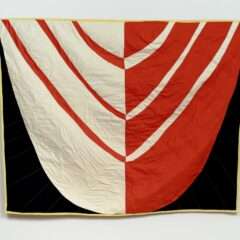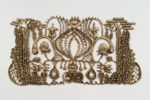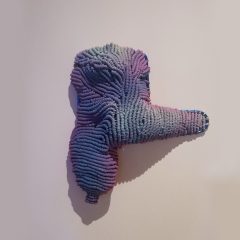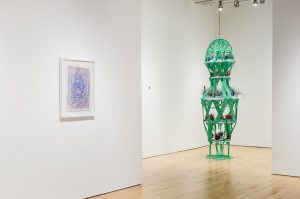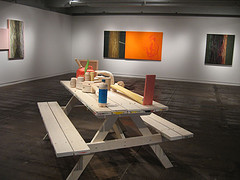
Death of the Sunshine Patriot (front), by Isaac Resnikoff, and paintings by Anda Dubinskis on the walls
Isaac Resnikoff’s picnic table looks just right in this hot weather, center stage at Fleisher/Ollman Gallery, part of a three-man show that also includes Anda Dubinskis and Mark Khaisman.
On the table sits a mix of carved tools, beverage containers, a hand as umbrella, fat candles, a guitar, a gas can–all the makings of a summer weekend of puttering around the house, hanging with friend, or pitching woo. The delicate paint drips applied along the side add a nice touch of dripping sweat, condensation or incomplete repair work. Resnikoff’s materials are his part and parcel of his content–the homespun ideal of the mister in the basement woodshop.
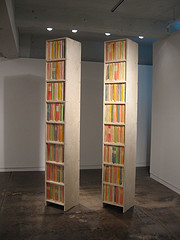
The Complete History of the USA, Versions 1 and 2
Beyond the table, two faux bookcases are the twin towers, and suddenly that table takes on an iconic importance as a way of life so easily disrupted. No wonder the table and its adornments are named Death of the Sunshine Patriot.
The “books” suggest left-wing thinking, right-wing thinking, social movements, chapters from the past–Our Town, All the President’s Men, On the Road, The Plot Against America. At first I thought the two towers–The Complete History of the USA, Versions 1 and 2–stood for different political positions or world views, but as I read title after title, I realized they couldn’t really be pigeonholed into liberal versus conservative. The diversity of views and the American self-image seem to be the point.
Resnikoff, who had been a member of Vox Populi after graduating with a BFA from Cooper Union 4 years ago, made me stand up a pay attention to his sweeping vision of American history in his first Fleisher/Ollman one-man show last fall (see post). He continues his exploration here (and even goes overseas to Liberia in one piece–hmm, can’t wait to see where that goes–Civil War here, civil war there?).
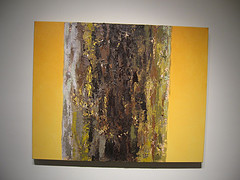
by Anda Dubinskis (you’ll have to tilt your head to see this one straight; sorry)
In the context of the mister in the woodshop, Dubinskis’ closeups of trees make a good fit. Dubinskis paints the bark in extreme closeup, the trees separated from their roots and their crowns. These are the trees that Jack built. And in many of her paintings, the diptychs, schoolbook outline illustrations of a Jill stands ready with a hatchet, considering the possibility of whether or how to take them down.
The work has a clear feminist bent, the world around the trees painted in flat, decorative wall colors like pinks, peaches and yellows. It’s by Jill’s leave that Jack gets to stand in the world she has painted. My favorites were the roughest of the barks, their colors illuminated as if from a nearby forest fire.
Dubinskis has been showing with Fleisher/Ollman for 22 years.
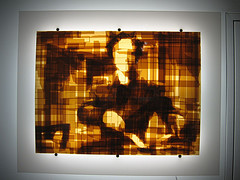
Pulled yourself together a bit? …That’s better, by Mark Khaisman
In this company, Mark Khaisman’s interpersonal scenarios play out as part of the same conversation.
Khaisman seemed to burst on the Philadelphia art scene not much more than a year ago with his “paintings” of flimsy brown packing tape on light boxes. He was a highly celebrated conceptual architect in Europe through the 1980s, and there’s a hint of non-English syntax in the titles of a couple of his paintings. This round, Khaisman has made the plaid grid more prominent, but the subject matter remains relationships. The simplified faces suggest we all are living scripted lives.
My favorite of the three exhibited was “Pulled yourself together a bit? …That’s better,” in which a woman is shown cooking (I presumed she was cooking eggs or some other comforting, routine thing, with her spatula in hand) as she looks up. Here we are, boys and girls together, figuring out how to live together and take care of eachother. It’s not always just about sex–but like the other two artists, Khaisman is exploring gender roles and societal expectations.
This excellent show, which is named Rip, Rig & Panic (don’t ask me why; I’m clueless even after reading why) after a 1965 album by Rahsaan Roland Kirk, continues Fleisher/Ollman’s incorporation of contemporary work into its exhibitions.
There are more images on Flickr.


